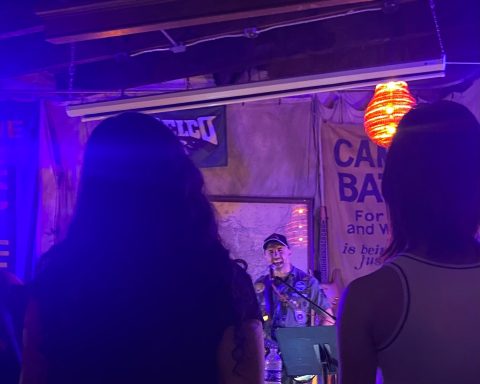Editor’s note: This article was initially published in The Daily Gazette, Swarthmore’s online, daily newspaper founded in Fall 1996. As of Fall 2018, the DG has merged with The Phoenix. See the about page to read more about the DG.
This past Sunday, the Swarthmore College Orchestra, conducted by Andrew Hauze ’04, performed a diverse repertoire for their fall concert. The program featured a performance by David Kim, concertmaster of the Philadelphia Orchestra.
The program opened with the orchestral premiere of Aytz Chaim (Tree of Life), written by Swarthmore jazz ensemble director Drew Shanefield. Shanefield had originally scored the piece for wind band, but he collaborated with Andrew Hauze to adapt it for the Swarthmore College Orchestra.
Shanefield took inspiration from both Jewish liturgy and a magnolia tree in his backyard while writing Aytz Chaim. “They seem to harmonize well,” Shanefield said. These inspirations are directly referenced in the themes of the music. The English horn opens the piece with a traditional Hebrew melody, while the piccolo weaves in and out of the music with a birdlike call.
Shanefield enjoyed the experience of returning to the piece to rescore it for orchestra. He appreciated the challenge of experimenting with the different sounds of the orchestra. “What do I lose in the conversion, but what am I going to gain in trying some colors?” Shanefield said, referencing the different colors of orchestral instruments.
Shanefield’s specific knowledge of the Swarthmore College Orchestra influenced his composition. “In some ways, [the piece] was custom written in the translation and adaptation for this group for this time, which was kind of neat,” Shanefield said.
Hauze, too, was pleased with the results of the collaboration. “It was great fun, and it was great to have the composer there to give his advice and to help make something new be heard,” Hauze said.
Lang Concert Hall was an ideal setting for the piece. The hall’s large window situated behind the performers looks out into the Crum woods. The connection with nature spoke to the themes of Shanefield’s piece.
Next, the orchestra played Jean Sibelius’s Violin Concerto in D Minor, op. 47, featuring David Kim as soloist. Kim played with both technical precision and deep emotion, and the piece evoked a feeling of longing. “[The piece] explores this whole other territory of sounds,” Hauze said. “A dark, murky texture that we don’t get to explore otherwise in our repertoire.”
Kim has visited Swarthmore in the past to give master classes and perform, and Hauze said he was thrilled to have the opportunity to conduct a concerto with him and the orchestra. He said he embraced Kim’s suggestion of Sibelius. “I’d been wanting to do a work by Sibelius with the orchestra for some time,” Hauze said. “So this was a perfect opportunity to do some Sibelius. I’m so glad we chose it.”
Hauze was pleased with Kim’s teaching style and was glad to work with him. He felt that Kim connected well with the orchestra. “[Kim] has a way of getting on the same wavelength with people, I think particularly with college students,” Hauze said.
In the evening’s third and final change of pace, the program concluded with Aaron Copland’s ballet-suite, Billy the Kid. The suite begins with a quiet duet played in perfect fifths, evoking the image of the open prairie. Other scenes are vividly described, including an intense gun battle featuring the snare drum. The piece concludes with a much louder repetition of the opening theme, returning to the image of the prairie.
Hauze loves Billy the Kid for its vibrancy. “Though it’s difficult to put together, it has a naturalness and an immediacy,” Hauze said. He felt that as a ballet, the piece’s rhythms invited movement and were physically engaging. “You can just dance with it,” Hauze said.
Hauze was highly impressed with the orchestra’s performance. “It certainly was […] the most difficult program we’ve ever done,” Hauze said. “Everyone just stepped up and they played their hearts out, and it just feels so wonderful conducting when everybody’s so into the music.”















